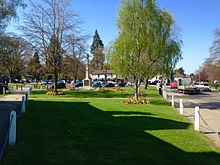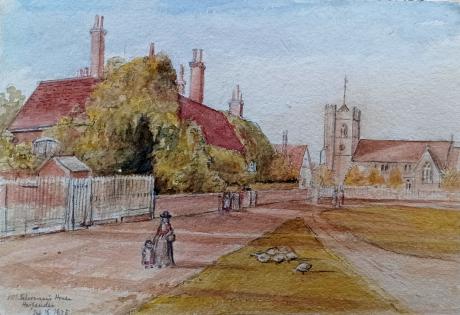inscribed and dated "Mr Schermann's House Harpenden Sep 16 1875" and sigend with initials "LWT"
Tom and Laura Taylor and thence by descent
The church of St Nicholas in Harpenden is a parish church in the Church of England. It is a Grade II* listed building. It is the oldest known church in Harpenden, Hertfordshire. It was originally built as a Chapel-of-Ease in about 1217, until it was enlarged and the existing tower added in 1470. The old church was demolished in 1861 to make way for a larger building. The tower contains a ring of eight bells, the oldest of which dates from 1612.
Harpenden remained part of the ecclesiastical parish of Wheathampstead until 1859 but was, from the Middle Ages, a separate civil parish with its own officials, who were elected annually at the Abbot's Manorial Court, held at Wheathampstead. In 1862, only three years after the long-sought separation from the parish of Wheathampstead, the church was rebuilt to accommodate the growing congregation.

The church is part of the Parish of Harpenden St Nicholas, a Church of England Parish within the Diocese of St Albans. Within the parish are two daughter churches, All Saints on Station Road in the Batford district to the east of Harpenden, and St Mary's on the northern outskirts. These churches have their own District Committees (as St Nicholas does) and enjoy a degree of autonomy and distinctive styles of worship.
Harpenden (/ˈhɑːrpəndən/) is a town and civil parish in the City and District of St Albans in the county of Hertfordshire, England. The population of the built-up area was 30,240 in the 2011 census, while the population of the civil parish was 29,448. Harpenden is a commuter town, with a direct rail connection to Central London.


There is evidence of pre-Roman Belgic farmers in the area. In 1867, several items were found including a bronze escutcheon, rams-head shaped mounts, and a bronze bowl.
There are Roman remains in land around Harpenden, such as the site of a mausoleum in the park at Rothamsted.A tumulus near the river Lea was opened in the 1820s and it contained a stone sarcophagus of Romano-Celtic origin. Five objects dating from around 150 AD, were inside, including a glass jug with a Mediterranean stamp and samian ware dishes used for libations.
Up to the 13th century, the area of the parish consisted of woodland with small hamlets and single farmsteads around cleared areas called "End" or "Green"; today, there are 19 Ends and 18 Greens in the areas of Harpenden and Wheathampstead parishes.
Harpenden village grew out of Westminster Abbey's gradual clearing of woodland for farming and settlement within its Wheathampstead manor, granted by Edward the Confessor in 1060. The first reference to a parish church was in 1221 (when it was referred to as Harpendene) so it is inferred that the village grew up around then. The church of St Nicholas is the oldest church in the town, originally built as a Chapel of ease in 1217.
Just beyond the southern edge of the town lies Nomansland Common (sometimes simply called "No Man's Land") upon which part of the Second Battle of St Albans was fought during the Wars of the Roses. Nomansland Common also saw the first annually contested steeplechase in England, in 1830, when it was organised by Thomas Coleman, and the last fight of 19th century bare-knuckle fighter Simon Byrne. It was also the haunt of the highwaywoman Lady Katherine Ferrers, better known as the "Wicked Lady".
A widespread but now little-known industry of Harpenden was straw-weaving, a trade mainly carried out by women in the 19th century. A good straw weaver could make as much as a field labourer. The straw plaits were taken to specialist markets in St Albans or Luton and bought by dealers to be converted into straw items such as boaters and other hats or bonnets.
The arrival of the railway system from 1860 and the sale of farms for residential development after 1880 radically changed Harpenden's surroundings. First the Dunstable Branch of the Great Northern Railway passed through the Batford area, with a station later named Harpenden East railway station (this line is now closed and forms a cycle track). The Midland Railway main line was built in 1868 with a station near the main village, which still exists today, and the listed Southdown Road Skew Bridge nearby.[10] The Harpenden and Hemel Hempstead Railway, known locally as the Nicky Line was opened in 1877.
Between 1848 and 1914 the common was a regular venue for horse racing. In his History of Hertfordshire in 1879, John Edwin Cussans commented "Notwithstanding that these meetings are under the most unexceptional patronage as regards the Stewards, yet for two days in the year all the London pickpockets, sharpers and blackguards who happen to be out of gaol are permitted to make Harpenden their own and to make travelling in a first-class carriage on the Midland Railway a danger to men and an impossibility to ladies." Golf has been played on the Common since 1894 and it was at that time Harpenden Golf Club was set up by a group of Harpenden people with the help and a financial contribution of 5 pounds from Sir John Bennet Lawes of Rothamsted Manor. The club moved to a new course at Hammonds End in 1931, at which time Harpenden Common Golf Club was formed by those who wanted to remain at the Common. In 1932 Bamville Cricket club was formed and shares part of the Common with the Golfers.
Harpenden is the home of Rothamsted Manor and Rothamsted Research (formerly Rothamsted Experimental Station and later the Institute of Arable Crops Research), a leading centre for agricultural research. In front of its main building, which faces the common, is a stone, erected in 1893, commemorating 50 years of experiments by Sir John Bennet Lawes and Joseph Henry Gilbert..
Lawes inherited the family estate at Rothamsted in 1834. Acknowledged as "the father of agricultural science", his early field experiments on Hertfordshire farms led him to patent a phosphate fertiliser, the sales of which enriched him immensely. With the proceeds, he established the experimental station, building laboratories in the 1850s. The station continued the development of the artificial fertilisers on which most modern farmers now depend. Some of the long-term 'classical field experiments' begun by Lawes and Gilbert remain in place to this day (such as Broadbalk) representing a unique resource for agricultural and environmental research.
In 1913 the National Children’s Home moved to Harpenden with a large site Highfield Oval which was home to over 200 children. The site featured a print works, a carpenters’ and joiners’ shop, a bootmakers shop and a farm where boys undertook apprenticeships. Girls were mainly trained in domestic service with some being trained in sewing and office work.The children lived in a "family" of 8-10 children each run by a sister or house mother. The chapel was gift from Joseph Rank and was built in 1928. The home was run on site until 1985. The site is now the head office of Youth with a Mission an international Christian missionary organization. The Harpenden Growth Study, one of the earliest longitudinal tests, was overseen by James Mourilyan Tanner and monitored the development of many of the children over a number of years.
During the Second World War, Harpenden was used to evacuate children from heavily bombed London. However, Harpenden was not totally confident in its safety, as evidenced by the now decaying Bowers Parade air raid shelters, soon to be secured for the future. It has been suggested both that it be used for educational and emergency training purposes. The Harpenden and District Local History Society has a collection of local material and archives which can be consulted, and holds regular meetings on topics of historical interest.
Laura Wilson Barker (6 March 1819 – 22 May 1905), was a composer, performer and artist, sometimes also referred to as Laura Barker, Laura W Taylor or "Mrs Tom Taylor".
She was born in Thirkleby, North Yorkshire, third daughter of a clergyman, the Rev. Thomas Barker. She studied privately with Cipriani Potter and became an accomplished pianist and violinist. As a young girl Barker performed with both Louis Spohr and Paganini. She began composing in the mid-1830s - her Seven Romances for voice and guitar were published in 1837. From around 1843 until 1855 she taught music at York School for the Blind. During this period some of her compositions - including a symphony in manuscript, on 19 April 1845 - were performed at York Choral Society concerts.
On 19 June 1855 she married the English dramatist, critic, biographer, public servant, and editor of Punch magazine Tom Taylor. Barker contributed music to at least one of her husband's plays, an overture and entr'acte to Joan of Arc (1871), and provided harmonisations as an appendix to his translation of Ballads and Songs of Brittany (1865).
Her other works include the cantata Enone (1850), the violin sonata A Country Walk (1860), theatre music for As You Like It, (April 1880), Songs of Youth (1884), string quartets, madrigals and solo songs. Her choral setting of Keats's A Prophecy, composed in 1850, was performed for the first time 49 years later at the Hovingham Festival in 1899. The composer was present.
Several of Barker's paintings hang at Smallhythe Place in Kent, Ellen Terry's house.
Barker lived with her husband and family at 84 Lavender Sweep, Battersea. There were two children: the artist John Wycliffe Taylor (1859–1925), and Laura Lucy Arnold Taylor (1863–1940). The Sunday musical soirees at the house attracted many well-known attendees, including Lewis Carroll, Charles Dickens, Henry Irving, Charles Reade, Alfred Tennyson, Ellen Terry and William Makepeace Thackeray.
Tom Taylor died suddenly at his home in 1880 at the age of 62. After his death, his widow retired to Porch House, Coleshill in Buckinghamshire, where she died on 22 May 1905, aged 86.

